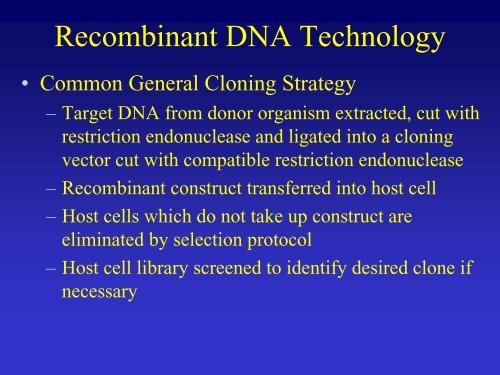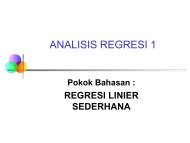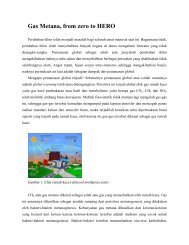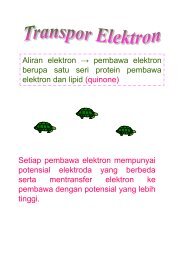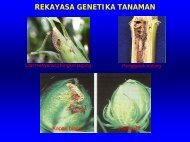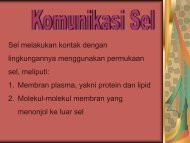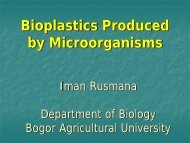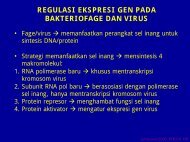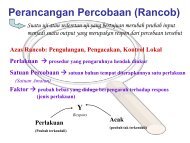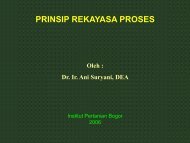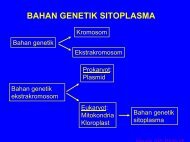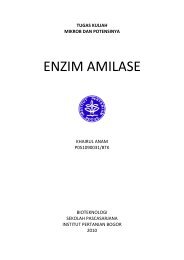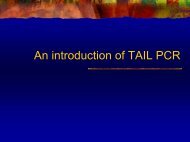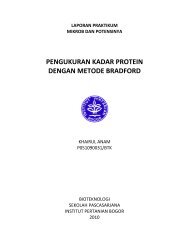Recombinant DNA Technology
Recombinant DNA Technology
Recombinant DNA Technology
- No tags were found...
Create successful ePaper yourself
Turn your PDF publications into a flip-book with our unique Google optimized e-Paper software.
<strong>Recombinant</strong> <strong>DNA</strong> <strong>Technology</strong><br />
• Common General Cloning Strategy<br />
– Target <strong>DNA</strong> from donor organism extracted, cut with<br />
restriction endonuclease and ligated into a cloning<br />
vector cut with compatible restriction endonuclease<br />
– <strong>Recombinant</strong> construct transferred into host cell<br />
– Host cells which do not take up construct are<br />
eliminated by selection protocol<br />
– Host cell library screened to identify desired clone if<br />
necessary
Cloning Into Bacterial Cells<br />
Restriction<br />
Endonuclease<br />
<strong>DNA</strong> Ligase<br />
transformation
<strong>DNA</strong> Cleavage By Restriction<br />
Endonucleases (2)
Recognition Sequences of Restriction<br />
Endonucleases
Restricti<br />
Mapping Restriction Endonuclease Cleavage Sites<br />
on<br />
Mappin<br />
g
<strong>DNA</strong> fragment sizes (in kilobase pairs) after<br />
single and double restriction endonucleases<br />
digestions of a plasmid
Restriction Endonuclease<br />
Cleavage Map<br />
• Created from single<br />
and multiple enzyme<br />
digestions<br />
• Useful markers for<br />
noting gene locations<br />
and subcloning<br />
strategies
Enzymes Used In <strong>Recombinant</strong> <strong>DNA</strong> Protocols
Annealing of Complementary “Sticky” Ends
T4 <strong>DNA</strong> Ligase Action
Early Cloning Vectors<br />
• pBR322<br />
• Plasmid<br />
• Small independent<br />
replicon with<br />
selectable markers and<br />
useful cloning sites
Cloning <strong>DNA</strong> Into a<br />
Plasmid Vector<br />
• Restriction endonuclease<br />
cleave vector/target<br />
• Phosphatase vector<br />
• Ligate target into vector<br />
• Transform into host cells
Other Plasmid Cloning Vectors<br />
• Now too many to count<br />
• Many specialized for expression, etc.<br />
• pUC series<br />
– Multiple cloning sites<br />
– Improved reporter/selection genes
Multiple Cloning Sites<br />
• Synthetic oligonucleotide construction<br />
• “Polymer of cutting sites”<br />
• Can be included in reporter gene coding<br />
sequence (e.g. lacZ’)
Antibiotics Commonly Used as Selective<br />
Agents
Creating and Screening a<br />
<strong>Recombinant</strong> <strong>DNA</strong> Library<br />
• A library is a collection of subdivided<br />
portions of a larger genetic element or<br />
genome<br />
• Commonly created by partial digestion of<br />
genomic <strong>DNA</strong> with restriction<br />
endonuclease and cloning the fragments<br />
into vectors (plasmid, phage, etc.)<br />
• Resultant transformed collection of cells is<br />
called a library
Partial Restriction Endonuclease<br />
Digestion of <strong>DNA</strong>s
Partial Digestion Profile<br />
• Collect fragments of a given<br />
target size after digestions for<br />
different times or using<br />
different restriction<br />
endonuclease concentrations<br />
• Size fractionate and combine<br />
fractions of desired target size
Genome Sizes of Various Organisms<br />
• The number and size<br />
of library clones<br />
required to be<br />
screened to find a<br />
single copy gene<br />
varies according to<br />
the genome size of<br />
the organism to be<br />
studied
Screening by Hybridization<br />
Probes: <strong>DNA</strong> or RNA<br />
100+ bp in size good<br />
Sequence match >80% best<br />
Stringency conditions
Production of Labeled Probes<br />
Random Primer Method
Three Activities of E. coli <strong>DNA</strong>P I (1)<br />
(1)<br />
• Polymerization of dNTPs<br />
at the 3’end of the growing<br />
chain (1)<br />
• 5’exonuclease removes<br />
nucleotides from 5’end of<br />
chain immediately<br />
upstream of growing chain<br />
(2)<br />
• 3’exonuclease removes<br />
unpaired nucleotides from<br />
3’ end of growing chain
Three Activities of E. coli <strong>DNA</strong>P I (2)<br />
(2)<br />
(3)<br />
Note that the 5’exonuclease is used in nick translation and the<br />
3’exonuclease activity is used for the proofreading function
Screening Colonies by Hybridization<br />
• Nucleic acid probe<br />
• Cells transferred to<br />
nylon membrane and<br />
lysed<br />
• <strong>DNA</strong> binds to<br />
membrane, is<br />
denatured and probe<br />
hybridized<br />
• Bound probe detected<br />
by autoradiography<br />
after washing<br />
membrane
Screening by Immunological Assay
Screening by Functional<br />
Complementation<br />
• Requires strain unable<br />
to produce desired<br />
product/function<br />
• Cloned <strong>DNA</strong>s must be<br />
in expression vector or<br />
include elements<br />
required for<br />
expression<br />
• Select for restoration<br />
of lost function
Isolation of Poly(adenylated)<br />
mRNAs<br />
Matrix
c<strong>DNA</strong><br />
Synthesis<br />
• Oligo(dT) primer<br />
• Reverse transcriptase<br />
• Klenow/<strong>DNA</strong>P I<br />
• RNase H<br />
• Degrades RNA of<br />
<strong>DNA</strong>:RNA hybrid<br />
• S1 nuclease<br />
• Degrades ss nucleic<br />
acids (unpaired<br />
loop)
Enriching for Full<br />
adapter<br />
Length c<strong>DNA</strong>s (1)<br />
• Primer has adapter (RE<br />
cutting sequence)<br />
• Ribose ends of mRNA are<br />
biotinylated<br />
• RNase I degrades ss RNA<br />
• Only full length c<strong>DNA</strong> is<br />
still attached to a<br />
biotinylated mRNA<br />
(biotin still on 5’end)<br />
• Capture full length copies
Enriching for Full Length c<strong>DNA</strong>s (2)<br />
• RNase H degrades mRNA<br />
• Add poly(G) to c<strong>DNA</strong><br />
• Primer/Adapter with oligo<br />
(C)<br />
• <strong>DNA</strong>P I (Klenow)<br />
• Restriction endonucleases<br />
• Cut Vector<br />
• <strong>DNA</strong> Ligase<br />
• Transform
Inert Capacities Common Vector<br />
Systems
Bacteriophage Lambda Life Cycle<br />
• Lysogenic phage<br />
• Lysogeny vs. lytic cycle<br />
• Chromosome about 50<br />
kb<br />
• Protein coat for efficient<br />
delivery into cells (E.<br />
coli)<br />
• Packages <strong>DNA</strong> 38-52 kb<br />
with cos sites at each end<br />
• <strong>DNA</strong> Replication is by<br />
rolling circle mechanism
Packaging of λ Chromosomes<br />
• Natural <strong>DNA</strong> is concatemer with cos sites<br />
separated by about 50 kb (from rolling circle<br />
replication<br />
• <strong>DNA</strong> is cleaved at cos and inserted into capsid
Mature λ Phage<br />
• <strong>DNA</strong> packaged in<br />
protein coat<br />
• Looks much like a<br />
lunar lander (actually<br />
has six tail fibers)
Phage λ cloning<br />
vector<br />
• Internal segment deleted<br />
(now requires helper<br />
phage to replicate)<br />
• Has cos sites intact<br />
• Target <strong>DNA</strong> inserted<br />
between the two λ<br />
“arms” (up to about 20<br />
kb)<br />
• <strong>DNA</strong> packaged in vitro<br />
• <strong>Recombinant</strong> phage<br />
infect E. coli cells
Cosmid Cloning System<br />
λ cos sites inserted<br />
into a small<br />
plasmid<br />
Target <strong>DNA</strong> ligated<br />
between two cosmid<br />
<strong>DNA</strong> molecules<br />
<strong>Recombinant</strong> <strong>DNA</strong><br />
packaged and E. coli<br />
Infected as before<br />
Can clone <strong>DNA</strong>s up<br />
to 45 kb
High-Capacity Bacterial Vector<br />
Systems<br />
• 100-300 kb target size<br />
• P1 bacterial systems<br />
• F plasmid systems<br />
• BACs (bacterial artificial chromosomes
Genetic Transformation of<br />
Prokaryotes<br />
• Chemical transformation<br />
• Usually involves CaCl 2 and heat shock<br />
• Transformation frequency about 1/1000<br />
• Electroporation<br />
• Electric field mediated membrane<br />
permeabilization<br />
• 10-100 times more efficient that chemical<br />
approach<br />
• Much better for large plasmids (100+ kb)
Electroporation<br />
• Cells suspended in <strong>DNA</strong><br />
solution in cuvette<br />
between two electrodes<br />
• High voltage electric field<br />
pulses administered<br />
• <strong>DNA</strong> migrates through<br />
HVEF induced openings<br />
in cells
Conjugation<br />
• Natural system of transmitting plasmids from<br />
one cell/strain to another<br />
• Requires specific <strong>DNA</strong> sequences on<br />
transferred plasmid and certain proteins which<br />
can be provided in trans<br />
• Plasmids of >10 6 bp can be transferred in this<br />
manner<br />
• Can be interspecies<br />
• Tripartite mating and multiple selection
Tripartite Mating<br />
• P. putida difficult to<br />
transform<br />
• Transform mobilizable<br />
recombinant plasmid<br />
into E.coli<br />
• Make culture with P.<br />
putida (wt),<br />
recombinant E. coli<br />
(auxotroph) and E. coli<br />
(aux) with conjugative<br />
mobilizable plasmid<br />
• <strong>Recombinant</strong> plasmid<br />
transferred to P. putida


